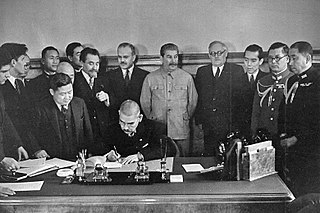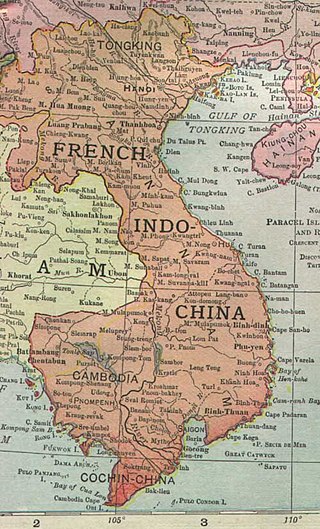
The Axis powers, originally called the Rome–Berlin Axis, was a military coalition that initiated World War II and fought against the Allies. Its principal members were Nazi Germany, the Kingdom of Italy, and the Empire of Japan. The Axis were united in their far-right positions and general opposition to the Allies, but otherwise lacked comparable coordination and ideological cohesion.

The Tripartite Pact, also known as the Berlin Pact, was an agreement between Germany, Italy, and Japan signed in Berlin on 27 September 1940 by, respectively, Joachim von Ribbentrop, Galeazzo Ciano, and Saburō Kurusu and in the presence of Adolf Hitler. It was a defensive military alliance that was eventually joined by Hungary, Romania, Bulgaria, and Yugoslavia as well as by the German client state of Slovakia. Yugoslavia's accession provoked a coup d'état in Belgrade two days later. Germany, Italy, and Hungary responded by invading Yugoslavia. The resulting Italo-German client state, known as the Independent State of Croatia, joined the pact on 15 June 1941.
The Hull note, officially the Outline of Proposed Basis for Agreement Between the United States and Japan, was the final proposal delivered to the Empire of Japan by the United States of America before the attack on Pearl Harbor and the Japanese declaration of war. The note, delivered on November 26, 1941, is named for Secretary of State Cordell Hull. It was the diplomatic culmination of a series of events leading to the attack on Pearl Harbor. Notably, its text repeats previous American demands for Japan to withdraw from China and from French Indochina. No further American proposals were made before the attack on Pearl Harbor, as the US government had received intelligence that Japan was preparing an invasion of Thailand.

The Soviet–Japanese Neutrality Pact, also known as the Japanese–Soviet Non-aggression Pact, was a non-aggression pact between the Soviet Union and the Empire of Japan signed on April 13, 1941, two years after the conclusion of the Soviet-Japanese Border War. The agreement meant that for most of World War II, the two nations fought against each other's allies but not against each other. In 1945, late in the war, the Soviets scrapped the pact and joined the Allied campaign against Japan.

The causes of World War II have been given considerable attention by historians. The immediate precipitating event was the invasion of Poland by Nazi Germany on September 1, 1939, and the subsequent declarations of war on Germany made by Britain and France, but many other prior events have been suggested as ultimate causes. Primary themes in historical analysis of the war's origins include the political takeover of Germany in 1933 by Adolf Hitler and the Nazi Party; Japanese militarism against China, which led to the Japanese invasion of Manchuria and the Second Sino-Japanese War; Italian aggression against Ethiopia, which led to the Second Italo-Ethiopian War, the consent of Western countries to Germany's actions on the annexation of Austria and the partition of Czechoslovakia and Germany's initial success in negotiating the Molotov–Ribbentrop Pact with the Soviet Union to divide the territorial control of Eastern Europe between them.

Germany–Japan relations were officially established in 1861 with the first ambassadorial visit to Japan from Prussia. Japan modernized rapidly after the Meiji Restoration of 1868, often using German models through intense intellectual and cultural exchange. After Japan aligned itself with Britain in 1900, Germany and Japan became enemies in World War I. Japan declared war on the German Empire in 1914 and seized key German possessions in China and the Pacific.

The Franco-Thai War was fought between Thailand and Vichy France over certain areas of French Indochina.

Relations between the Soviet Unionand Japan between the Communist takeover in 1917 and the collapse of Communism in 1991 tended to be hostile. Japan had sent troops to counter the Bolshevik presence in Russia's Far East during the Russian Civil War, and both countries had been in opposite camps during World War II and the Cold War. In addition, territorial conflicts over the Kuril Islands and South Sakhalin were a constant source of tension. These, with a number of smaller conflicts, prevented both countries from signing a peace treaty after World War II, and even today matters remain unresolved.
The Iberian Pact or Peninsular Pact, formally the Portuguese–Spanish Treaty of Friendship and Non-Aggression, was a non-aggression pact that was signed at Lisbon, just a few days before the end of the Spanish Civil War, on 17 March 1939 by Portuguese Prime Minister António de Oliveira Salazar, representing Portugal, and Ambassador Nicolás Franco, representing Spain. The treaty was ratified on 25 March 1939.
The Franco-Soviet Treaty of Mutual Assistance was a bilateral treaty between France and the Soviet Union with the aim of enveloping Nazi Germany in 1935 to reduce the threat from Central Europe. It was pursued by Maxim Litvinov, the Soviet foreign minister, and Louis Barthou, the French foreign minister, who was assassinated in October 1934, before negotiations had been finished.

Thailand officially adopted a neutral position during World War II until the five hour-long Japanese invasion of Thailand on 8 December 1941, which led to an armistice and military alliance treaty between Thailand and the Japanese Empire in mid-December 1941. At the start of the Pacific War, the Japanese Empire pressured the Thai government to allow the passage of Japanese troops to invade British-held Malaya and Burma. After the invasion, Thailand capitulated. The Thai government under Plaek Phibunsongkhram considered it profitable to co-operate with the Japanese war efforts, since Thailand saw Japan – who promised to help Thailand regain some of the Indochinese territories which had been lost to France – as an ally against Western imperialism. Following added pressure from the start of the Allied bombings of Bangkok due to the Japanese occupation, Axis-aligned Thailand declared war on the United Kingdom and the United States and annexed territories in neighbouring countries, expanding to the north, south, and east, gaining a border with China near Kengtung.
The Japanese occupation of Cambodia was the period of Cambodian history during World War II when the Kingdom of Cambodia was occupied by the Japanese. Vichy France, who were a client state of Nazi Germany, nominally maintained the French protectorate over Cambodia and other parts of Indochina during most of the Japanese occupation. This territory of Cambodia was reduced, by concessions to Thailand after the Franco-Thai War, so that it did not include Stung Treng Province, Battambang Province, and Siem Reap Province.
The timeline of the Molotov–Ribbentrop Pact is a chronology of events, including Molotov–Ribbentrop Pact negotiations, leading up to, culminating in, and resulting from the Molotov–Ribbentrop Pact. The Treaty of Non-aggression between Nazi Germany and the Soviet Union was signed in the early hours of 24 August 1939, but was dated 23 August.

Cambodia–Japan relations are foreign relations between Cambodia and Japan. Japan has an embassy in Phnom Penh and Cambodia has an embassy in Tokyo.
An agreement concluded between the Soviet and the Norwegian governments in Christiania on 2 September 1921 to regulate their relations. It was ratified by the Soviet government on 19 September and by the Norwegian government on 1 October. The agreement went into effect on 1 October 1921 and was registered in League of Nations Treaty Series on 19 December 1921.

The Soviet–Estonian Mutual Assistance Treaty, also known as the Bases Treaty was a bilateral treaty between the Soviet Union and Estonia, signed in Moscow on 28 September 1939. The treaty obliged both parties to respect each other's sovereignty and independence, and allowed the Soviet government to establish military bases in Estonia. These bases facilitated the Soviet takeover of the country in June 1940.

The Soviet–Latvian Mutual Assistance Treaty was a bilateral treaty between the Soviet Union and Latvia, signed in Moscow on October 5, 1939. The treaty obliged both parties to respect each other's sovereignty and independence, while in practice allowed the Soviet government to establish military bases in Latvia, which facilitated the Soviet invasion of the country in June 1940.
The Anglo-Thai Non-Aggression Pact was concluded in Bangkok on 12 June 1940 between the governments of the United Kingdom and the Kingdom of Thailand. It was concluded as part of the British policy, which was to refrain from resisting by force the actions of the Japanese Empire in East Asia, as Thailand was about to become Japan's ally.

Lan Chang Province was a former province of the Kingdom of Thailand. It encompassed the eastern slopes of the Luang Prabang Range in Laos, with Xaignabouli (Sainyabuli) as the administrative headquarters. It included parts of former the Luang Prabang and Xaignabouli provinces of French Laos.
The Settlement Agreement between France and Siam was concluded in Washington DC on November 17, 1946 in order to settle the consequences of the Franco-Thai War of 1940-1941. The agreement went into effect on the day of its conclusion and was registered in the United Nations Treaty Series on October 16, 1959.











